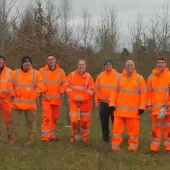Mannok praised for leading by example

Company launches comprehensive natural assets action plans in partnership with Ulster Wildlife
MANNOK have launched a comprehensive, forward-thinking biodiversity report, their Natural Assets Action Plans (NAAP), which was completed by Ulster Wildlife in partnership with the Mannok environmental team.
The report, which has taken more than 12 months to complete, examines every area of Mannok’s landholdings, which span almost 2,000 acres in 47 separate locations both north and south of the Irish border.
The aim was to measure and record the environmental status and biodiversity of each area. It also provides a roadmap for the conservation, restoration, and enhancement of every area of land, to help meet Mannok’s ambitious sustainability targets.
The report was launched at a dedicated event on 21 September, attended by Northern Ireland Minister for Agriculture, Environment and Rural Affairs, Edwin Poots MLA, the Ulster Wildlife delivery team, Mannok’s environmental team and company directors, local political representatives, and local community partners.
Presenting the key findings from the report at the event on behalf of Ulster Wildlife, Dr Michael Meharg and Professor Jim McAdam highlighted the significance of the work undertaken, which provides a thorough and detailed assessment of various land types, including grasslands, wetlands, woodlands, ponds, and quarries.
They explained how the report and subsequent actions will benefit the environment locally and leave a positive legacy by:
- Increasing awareness and understanding of biodiversity among Mannok staff, customers, and the local community
- Improving monitoring, measuring, and reporting of biodiversity
- Calculating and maximizing the carbon-absorbing and storing figures in the lands’ soil and vegetation
- Using Mannok landholdings for rewilding the natural landscape, ensuring the wildlife, weather and land are functioning positively together, following the Government-led Nature Recovery Networks commitment
- Ensuring that Mannok landholdings are resilient to predicted climate change effects
- Working with local communities to care for the special landscapes
- Looking at the bigger picture across the Fermanagh/Cavan border area to contribute to larger landscapes.
‘We commissioned the report to understand our natural assets and to provide a baseline for the enhancement of the local environment and varieties of wildlife in the short, medium, and long term,’ said Mannok chief executive officer Liam McCaffrey.
‘This report informs our understanding of the value of natural assets to the business and wider community and will help guide our long-term planning and strategic investment decisions in a way which aims to maintain and enhance those assets.
‘The report is a comprehensive one, achieving our ambition to create an exemplar study which is not selective in areas of land which it considers, but covers all Mannok assets.
‘Already it has started to change our perspectives of what was previously considered wasteland. Now, we can see opportunities for careful and considered restoration into valuable natural assets for the future.
‘Additionally, the work involved in creating the plan has allowed us to focus on the whole area of carbon mitigation in ways which we would not have considered before. The way in which we are looking at carbon reduction through careful management of our land is a relatively novel concept in industry, but we now recognize it as a critical tool in the fight against climate change.
‘We must and will now take ownership of this report and the actions contained in it. The report is full of very valuable recommendations on what we can practically do over the next three to five years and beyond to continue enhancing and restoring our land assets, and we are very much committed to delivering on this. We will commit resources, time, people and finances to develop the recommendations.’
Acknowledging the environmental leadership shown by Mannok, Edwin Poots MLA, Minster for Agriculture, Environment and Rural Affairs, commented: ‘I commend the action being taken by Mannok in partnership with Ulster Wildlife to produce an action plan for the biodiversity and carbon assets on their land. This will greatly contribute to the Executive’s Green Growth Strategy and both the Biodiversity Strategy and Peatland Strategy currently being developed.
‘Putting sustainability at the heart of our economic recovery from COVID-19 is key to creating a resilient economy and healthy environment for all. Green Growth is recognized globally as an approach to achieve economic growth and development while ensuring natural assets continue to provide the resources and environment on which our well-being depends.
‘I would like to encourage other businesses to follow Mannok’s example, taking steps such as this will help all of us reap the benefits of our ‘Green Recovery,’ now and in the years to come as we look towards the launch of our ‘Green Growth’ Strategy in 2021.’
The study provides an integrated approach to biodiversity management and reinforces Mannok’s existing ecological assessments, demonstrating that sensitive management of quarry areas and other landholdings has the potential to benefit the variety of wildlife present and assist carbon sequestration.
Sharing further details on the NAAP, Jennifer Fulton, chief executive officer of Ulster Wildlife, said: ‘The Natural Assets Action Plan has been completed to the International Union of the Conservation of Nature (IUCN) biodiversity management standards for the cement and aggregates sector. Responsible industry leaders recognize the importance of safeguarding and positively managing biodiversity in and around their land holdings to demonstrate good land stewardship.
‘Mannok own and manage a significant land portfolio and it is very encouraging to see their interest and intent to maximize the biodiversity and carbon benefits, making a positive contribution to global and local environmental challenges.’
At the launch event, Mannok sustainability manager Paul Monaghan explained how the action plans would form a crucial part of Mannok’s overarching sustainability strategy, which focuses on three key pillars of people, planet, and partners.
The significant benefit to the local community and Mannok’s commitment to sustainability was acknowledged by Dr Lisa McIlveen, deputy managing director of Business in the Community, who commented: ‘It takes a brave organization to step up and do some of the top things in what it means to be a responsible, sustainable business and that’s why I have to really commend Mannok for doing this piece of work, and also their whole approach to sustainability.
‘There are no ‘no-go’ areas whenever it comes to Mannok discussing what it means to be a sustainable and responsible business. It’s so refreshing for me to work with an organization that takes that type of approach to sustainability.’









